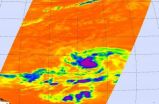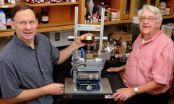(Press-News.org) Hurricane Earl is still a powerful category four hurricane on the Saffir-Simpson Scale as it approaches the North Carolina coast today. NASA's Tropical Rainfall Measuring Mission (TRMM) satellite observed the high rates rain was falling within Earl, in some areas more than 2 inches per hour. Today, the Global Hawk unmanned aircraft is also flying into the eye of Hurricane Earl at altitudes of 60,000 feet to gather information about the storm.
Hurricane Earl became the most powerful hurricane of the 2010 Atlantic season early on September 2 when its sustained winds reached 120 kts (~138 mph). It was still intensifying when the TRMM satellite passed near its location on 2 September 2010 at 0602 UTC (2:02 a.m. EDT). The TRMM Microwave Imager (TMI) data were used in the rainfall analysis that showed heavy rainfall, particularly in the northwest quadrant of Earl's very distinct circular eye. TRMM is managed by NASA and the Japanese Space Agency, and images are created at NASA's Goddard Space Flight Center, Greenbelt, Md.
As NASA's Genesis and Rapid Intensification experiment (GRIP) continues to investigate tropical cyclones until Sept. 30, the unmanned Global Hawk aircraft was making fly overs of Hurricane Earl today to gather data from 60,000 feet high, into the lower levels of the stratosphere. This data will help scientists learn about the rapid intensification of Earl, who went from a Category 2 to a Category 4 hurricane earlier this week.
In addition to the GRIP Mission, astronauts aboard the International Space Station are also capturing Hurricane Earl on video and in photographs. These images complement the Global Hawk's view closer to Earth. In addition, NASA satellites, such as the Aqua satellite are capturing views of Earl . The Moderate Resolution Imaging Spectroradiometer (MODIS) instrument has been providing high-resolution views of Earl's clouds since it was born. To see an image from Sept. 1 at 18:01 UTC (2:01 p.m. EDT) of Hurricane Earl as it was moving through the Bahamas, go to: http://rapidfire.sci.gsfc.nasa.gov/gallery/?2010244-0901/Earl.A2010244.1801/.
Today, September 2, Hurricane warnings extend from North Carolina north to Massachusetts, including Cape Cod and the islands, with tropical storm warnings that include Virginia, eastern Maryland, New Jersey, New York, Connecticut and Rhode Island. Hurricane Earl's eye is expected to stay off-shore and eastern North Carolina and eastern Massachusetts have the strongest warnings.
At 11 a.m. EDT on September 2, Hurricane Earl had maximum sustained winds near 140 mph. It was 300 miles south of Cape Hatteras, NC, and 765 miles south-southwest of Nantucket, Mass. near 30.9N and 74.8W. It is moving north at 18 mph and has a minimum central pressure of 932 millibars.
For complete watches and warnings, and forecast track, go to the National Hurricane Center's webpage: www.nhc.noaa.gov.
NASA satellite imagery indicates this is a large storm, with hurricane force winds extend outward up to 90 miles from the center and tropical storm force winds extend outward up to 230 miles.
###
NASA catches heavy rainfall happening in Category 4 Earl as it approaches the US
2010-09-04
ELSE PRESS RELEASES FROM THIS DATE:
Laser-based missile defense for helicopters being developed
2010-09-04
ANN ARBOR, Mich.---Protecting helicopters in combat from heat-seeking missiles is the goal of new laser technology created at the University of Michigan and Omni Sciences, Inc., which is a U-M spin-off company.
"Battlefield terrain in places like Afghanistan and Iraq can be so rough that our troops have often had to rely on helicopters, and they can be easy targets for enemies with shoulder-launched missiles," said Mohammed Islam, a professor in the Department of Electrical Engineering and Computer Science.
"Our lasers give off a signal that's like throwing sand in ...
Bermuda in warnings as the GOES-13 Satellite catches Fiona approaching
2010-09-04
Bermuda has warnings up as Tropical Storm Fiona approaches, and GOES-13 satellite imagery from today shows that Fiona, although packing a punch, is a much smaller system that her brother, the Category 4 Hurricane Earl.
A tropical storm warning is in effect for Bermuda today, Sept. 2, as tropical storm force winds are expected there by late Friday. Bermuda can expect between 1 to 3 inches of rainfall from Fiona.
When the Geostationary Operational Environmental Satellite called GOES-13 captured a visible image of Tropical Storm Fiona approaching Bermuda this afternoon ...
Cigarette smoke may contribute to lung inflammation through a new chemical pathway
2010-09-04
BIRMINGHAM, Ala. – Cigarette smoke shuts off a key enzyme in airways that regulates the body's response to inflammation, according to findings from the University of Alabama at Birmingham published online today at Science Express.
The UAB researchers say smoke inhibits the enzyme, called Leukotriene A4 Hydrolase (LTA4H), causing it to fail in its job of shutting down white blood cells following a successful response to inflammation.
The team says the research study identified a previously unknown substrate of LTA4H called proline-glycine-proline (PGP). In a normal ...
New model may simplify high-dose radiosurgery planning
2010-09-04
COLUMBUS, Ohio – There is yet no straightforward way to determine the optimal dose level and treatment schedules for high-dose radiation therapies such as stereotactic radiation therapy, used to treat brain and lung cancer, or for high-dose brachytherapy for prostate and other cancers.
Radiation oncologists at the Ohio State University Comprehensive Cancer Center-Arthur G. James Cancer Hospital and Richard J. Solove Research Institute (OSUCCC-James) may have solved the problem by developing a new mathematical model that encompasses all dose levels.
Typically, radiation ...
American Society for Biochemistry and Molecular Biology reacts to stem-cell ruling
2010-09-04
BETHESDA, Md., Sept. 2, 2010 – The American Society for Biochemistry and Molecular Biology expressed its disapproval and disappointment this week in response to the Aug. 23 ruling in the U.S. District Court for the District of Columbia that granted a preliminary injunction barring federal funding of embryonic stem-cell research.
In a statement, the society said the decision, which came in response to a lawsuit filed by two adult stem-cell researchers, effectively halts human embryonic stem-cell research in the United States and "represents a crossroads in American scientific ...
Report: Discovery networks hostage-taking a rare terror event
2010-09-04
COLLEGE PARK, Md. – A new report by terrorism researchers at the University of Maryland concludes that the deadly hostage-taking incident at the Discovery Communications headquarters in suburban Washington, D.C. meets the criteria of a terrorist act – a rare one for media organizations and the nation's capital region. Hostage-taking, though, is a familiar pattern in capital-region terror, the researchers add.
The report from the University of Maryland's START Center – the federally funded National Consortium for the Study of Terrorism and Responses to Terrorism – also ...
NASA sees Depression Nine become Gaston then back to a depression
2010-09-04
Tropical Depression Nine strengthened yesterday into Tropical Storm Gaston, but today it ran into dry and stable air and weakened back into a depression again.
When NASA's Aqua satellite flew over Gaston early this morning, Sept. 2 at 0423 UTC (12:23 a.m. EDT), the infrared image taken from the Atmospheric Infrared Sounder (AIRS) instrument showed that Tropical Depression Gaston seemed to have a compact circulation with some high, cold thunderstorm cloud tops around its center of circulation. Those clouds reached so high into the troposphere that they were colder than ...
Iowa State chemists discover method to create high-value chemicals from biomass
2010-09-04
AMES, Iowa – Iowa State University researchers have found a way to produce high-value chemicals such as ethylene glycol and propylene glycol from biomass rather than petroleum sources.
Walter Trahanovsky, an Iowa State professor of chemistry who likes to write out the chemical structures of compounds when he talks about his science, was looking to produce sugar derivatives from cellulose and other forms of biomass using high-temperature chemistry. And so he and members of his research group studied the reactions of cellulosic materials in alcohols at high temperatures ...
Children who eat vended snack foods face chronic health problems, poor diet
2010-09-04
ANN ARBOR, Mich. — School children who consume foods purchased in vending machines are more likely to develop poor diet quality – and that may be associated with being overweight, obese or at risk for chronic health problems such as diabetes and coronary artery disease, according to research from the University of Michigan Medical School.
The study also looked at foods sold in school stores, snack bars and other related sales that compete with USDA lunch program offerings and found that these pose the same health and diet risks in school-aged children.
"The foods that ...
NASA satellite sees Tropical Storm Kompasu transitioning over Korea and China
2010-09-04
NASA's Terra satellite captured the changing Tropical Storm Kompasu over Korea and China very early today, as it makes its way east to northern Japan. It is becoming extratropical.
The Moderate Resolution Imaging Spectroradiometer (MODIS) instrument aboard NASA's Terra satellite captured a visible image of Tropical Storm Kompasu at 02:15 UTC on Sept. 2 (10:15 p.m. EDT Sept. 1) as it was moving over Korea and China. The storm appeared disorganized as there was no visible center of circulation. The Joint Typhoon Warning Center, the organization that forecasts tropical ...




